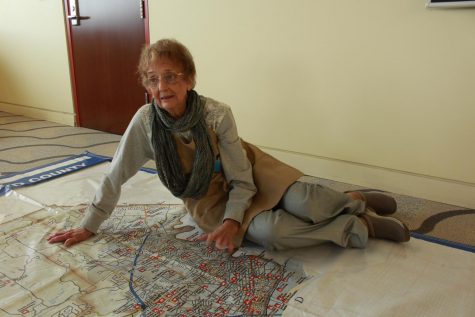Treasures hidden in the attic
Located on the third floor of the library, the Center for Cultural Resources is full of items and information waiting to be discovered.
Doll houses, garments, toys and bags are just a fraction of the treasures hidden in the CCR. Photo by Callie Manias.
March 4, 2019
Many students use the library to study or to do homework, but there are many other aspects of the library that are not well known to students. The Center for Cultural Resources (CCR) is part of the IU Southeast Curriculum Materials Center and contains kits with artifacts from different countries.
Claudia Crump and Carolyn Diener are cofounders of the CCR and they first started bringing artifacts back from trips in 1972. Their first trip was to the Soviet Union; they left their boots and jeans there so they could make room for artifacts in their suitcase.
When did it begin?
In 1993, the CCR had its first open house at IU Southeast and doors have been open ever since. “It was established at first to make aware the education students who were coming through here who had had very little, if any, contact with ethnic groups,” Crump said.
At the time, Crump was an instructor at IU Southeast and she got together with Diener and they decided the best way to integrate local people with cultures of the world was by having artifacts.
When she first started teaching with the artifacts, Crump brought in the items just for the day and then would have to take the items back home. Before long, she decided she would rather have a system for leaving the items there and have a way for students to be able to check out items.
“Our first group had about thirteen kits from places we had traveled, and now we have all the world,” said Crump.
In the beginning, education students were helping create the kits. The students were writing lesson plans using the kits and teaching with them at a local school.
From there, the students that became teachers wanted to take the kits out to schools where they were teaching. Crump worked with the library and developed a way to check out the items.

What is it?
Each kit has 400 to 500 items and is available to be checked out just like a book or a movie. The CCR mainly focuses on getting kits in the hands of teachers and students at local schools.
Each of the kits has a teacher notebook in it to guide teachers as they show the students the items in the kit. The kits are divided into 12 different themes, which help users learn about different cultures around the world.
Being the Library’s Liaison to the School of Education, Melanie Hughes understands the importance of teaching students about cultures. Hughes said, “I believe that the CCR is important because the artifacts, items of material culture, belonging from different peoples allow us to begin a dialogue about similarities and differences we all have as human beings on planet Earth, hopefully moving us closer to peace and understanding.”
“[The CCR operates to] open our world to the rest of the world and vice versa by showing how we are similar and not similar,” Crump said.
Madi Persinger, senior education major at IU Southeast, is currently student teaching at a local school in New Albany. “I emailed [the CCR] and got immediate responses with suggestions that were very beneficial, and multiple kit options that worked perfectly for the unit. I took a few of the artifacts into my class, and the kids absolutely loved it,” Persinger said.
Who can use it?
The CCR is open to anyone in the community, but users have to go through an orientation before checking out kits. The reasoning behind that is because of the organization of the kits and the items inside them.
To reserve a kit, users can reserve kits online, on the phone or in person.
The CCR is always available for IU Southeast students to come in and look around whenever the library is open. There is no staff because the organization is run by volunteers, but they are trying to build a staff with interns.
The majority of users that check out kits are local schools as a whole and groups of teachers. Currently, their main circulation is to festivals and fairs at local events and schools.
In the past, more classroom teachers checked out kits, but Crump said because of the emphasis on testing, teachers feel like they do not have time for other learning activities.
A future teacher, Persinger, said she feels lucky to have access to the CCR to create fun and engaging lessons for her future students when she has her own classroom.


